remove seats CITROEN C1 2018 Owners Manual
[x] Cancel search | Manufacturer: CITROEN, Model Year: 2018, Model line: C1, Model: CITROEN C1 2018Pages: 269, PDF Size: 7.63 MB
Page 12 of 269
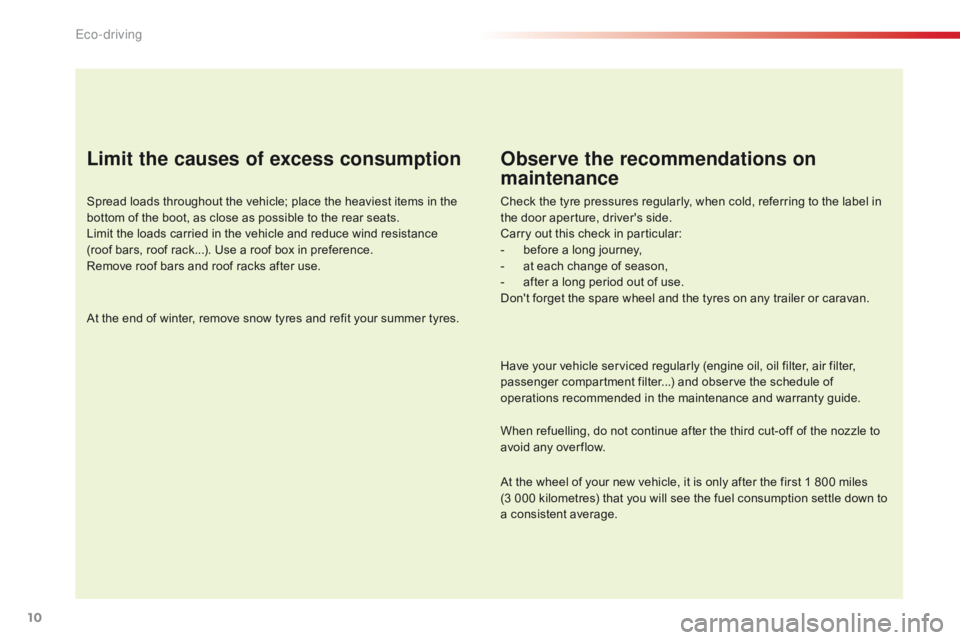
10
C1_en_Chap00c_eco-conduite_ed01-2016
Limit the causes of excess consumption
Spread loads throughout the vehicle; place the heaviest items in the bottom of the boot, as close as possible to the rear seats.
Limit
the loads carried in the vehicle and reduce wind resistance
(roof
bars, roof rack...). Use a roof box in preference.
Remove
roof bars and roof racks after use.
At
the end of winter, remove snow tyres and refit your summer tyres.
Observe the recommendations on
maintenance
Check the tyre pressures regularly, when cold, referring to the label in the door aperture, driver's side.
Carry
out this check in particular:
-
b
efore a long journey,
-
a
t each change of season,
-
a
fter a long period out of use.
Don't
forget the spare wheel and the tyres on any trailer or caravan.
Have
your vehicle serviced regularly (engine oil, oil filter, air filter,
p
assenger compartment filter...) and observe the schedule of
o
perations recommended in the maintenance and warranty guide.
When
refuelling, do not continue after the third cut-off of the nozzle to
a
void any over flow.
At
the wheel of your new vehicle, it is only after the first 1 800 miles
(
3 000 kilometres) that you will see the fuel consumption settle down to
a
consistent average.
Eco-driving
Page 124 of 269
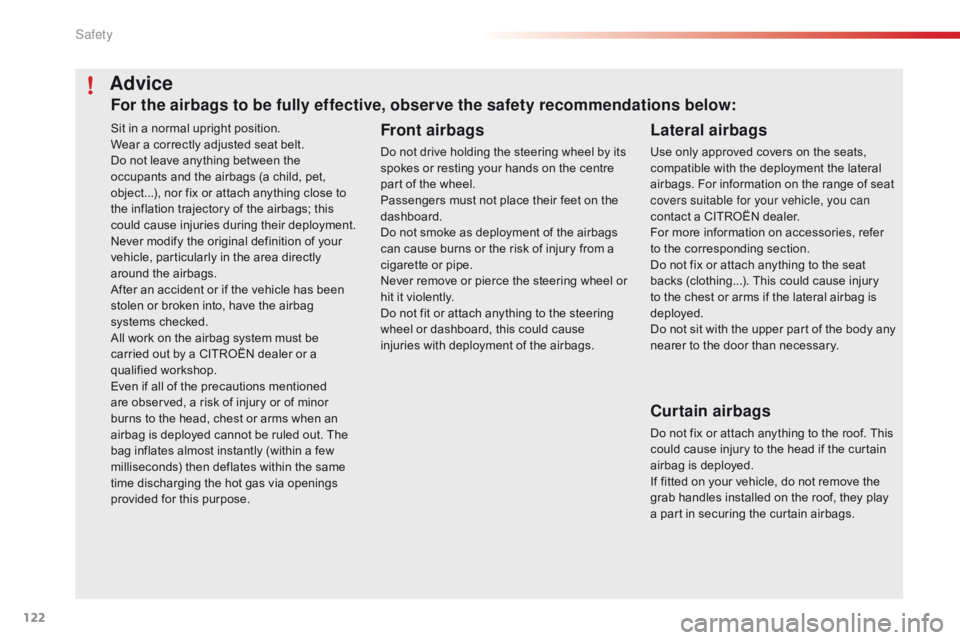
122
C1_en_Chap06_securite_ed01-2016
Sit in a normal upright position.
W ear a correctly adjusted seat belt.
Do
not leave anything between the
o
ccupants and the airbags (a child, pet,
o
bject...), nor fix or attach anything close to
t
he inflation trajectory of the airbags; this
c
ould cause injuries during their deployment.
Never
modify the original definition of your
v
ehicle, particularly in the area directly
a
round the airbags.
After
an accident or if the vehicle has been
s
tolen or broken into, have the airbag
s
ystems checked.
All
work on the airbag system must be
c
arried out by a CITROËN dealer or a
q
ualified
w
orkshop.
Even
if all of the precautions mentioned
a
re observed, a risk of injury or of minor
b
urns to the head, chest or arms when an
a
irbag is deployed cannot be ruled out. The
b
ag inflates almost instantly (within a few
m
illiseconds) then deflates within the same
t
ime discharging the hot gas via openings
p
rovided for this purpose.Front airbags
Do not drive holding the steering wheel by its spokes or resting your hands on the centre
p
art of the wheel.
Passengers
must not place their feet on the
das
hboard.
Do
not smoke as deployment of the airbags
c
an cause burns or the risk of injury from a
c
igarette or pipe.
Never
remove
or
pierce
the
steering
wheel
or
h
it it violently.
Do
not fit or attach anything to the steering
w
heel or dashboard, this could cause
i
njuries with deployment of the airbags.
Advice
Lateral airbags
Use only approved covers on the seats, compatible with the deployment the lateral
a
irbags. For information on the range of seat
c
overs suitable for your vehicle, you can
contact
a CITROËN dealer.
For
more information on accessories, refer
t
o the corresponding section.
Do
not fix or attach anything to the seat
b
acks (clothing...). This could cause injury
t
o the chest or arms if the lateral airbag is
d
eployed.
Do
not sit with the upper part of the body any
n
earer to the door than necessary.
Curtain airbags
Do not fix or attach anything to the roof. This could cause injury to the head if the curtain
a
irbag is deployed.
If
fitted on your vehicle, do not remove the
g
rab handles installed on the roof, they play
a
part in securing the curtain airbags.
For the airbags to be fully effective, observe the safety recommendations below:
Safety
Page 133 of 269
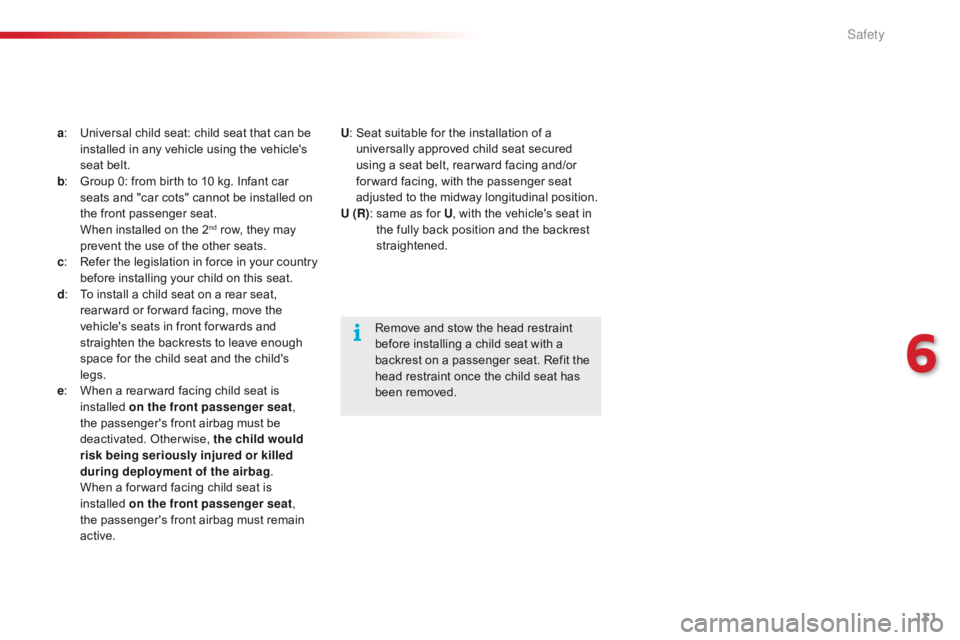
131
C1_en_Chap06_securite_ed01-2016
a: Universal child seat: child seat that can be i
nstalled in any vehicle using the vehicle's
s
eat belt.
b :
G
roup 0: from birth to 10 kg. Infant car
s
eats and "car cots" cannot be installed on
t
he
f
ront
p
assenger
sea
t.
W
hen installed on the 2
nd row, they may p
revent
the
use
of
the
other seats.
c :
R
efer
t
he
l
egislation
i
n
f
orce
i
n
y
our
c
ountry
b
efore
installing
your
child on this seat.
d :
T
o
install
a
child
seat
on
a rear seat,
r
ear ward
or
for ward
facing, move the
v
ehicle's
seats
in
front
for wards and
s
traighten
the
backrests
to leave enough
s
pace
for
the
child
seat
and the child's
l
egs.
e :
W
hen
a
rear ward
facing
child seat is
i
nstalled
o
n the front passenger seat ,
the
passenger's
front
airbag must be
d
eactivated.
O
therwise,
t
he child would
risk being seriously injured or killed
during deployment of the airbag .
W
hen
a
for ward
facing
child seat is
i
nstalled
o
n the front passenger seat ,
the
passenger's
front
airbag must remain
a
ctive. Remove
and stow the head restraint
b
efore installing a child seat with a
b
ackrest on a passenger seat. Refit the
h
ead restraint once the child seat has
b
een removed.
U
:
S
eat suitable for the installation of a
u
niversally approved child seat secured
u
sing a seat belt, rear ward facing and/or
f
or ward facing, with the passenger seat
a
djusted to the midway longitudinal position.
U (R) :
s
ame as for U
, with the vehicle's seat in t
he fully back position and the backrest s
traightened.
6
Safety
Page 134 of 269
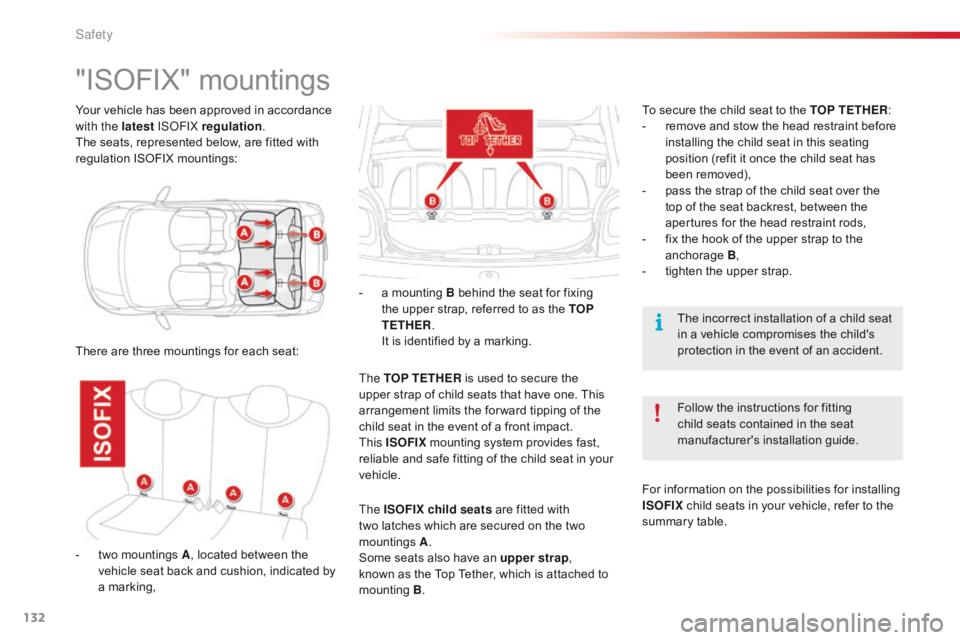
132
C1_en_Chap06_securite_ed01-2016
Your vehicle has been approved in accordance with the latest ISOFIX regulation .
The
seats, represented below, are fitted with
r
egulation
I
SOFIX
m
ountings:
"ISOFIX" mountings
There are three mountings for each seat: -
a
mounting B behind the seat for fixing
t
he upper strap, referred to as the TOP
TETHER . I t is identified by a marking.
The TOP TETHER is used to secure the
u
pper strap of child seats that have one. This
a
rrangement limits the for ward tipping of the
c
hild seat in the event of a front impact.
This ISOFIX
mounting system provides fast,
r
eliable and safe fitting of the child seat in your
v
ehicle. Follow
the instructions for fitting
c
hild seats contained in the seat
m
anufacturer's installation guide.
The
incorrect installation of a child seat
i
n a vehicle compromises the child's p
rotection in the event of an accident.
The ISOFIX child seats are fitted with
t
wo latches which are secured on the two
m
ountings
A.
S
ome seats also have an upper strap,
known
as the Top Tether, which is attached to
m
ounting
B. T
o secure the child seat to the TOP TETHER
:
-
r
emove and stow the head restraint before
i
nstalling the child seat in this seating
p
osition (refit it once the child seat has
b
een removed),
-
p
ass the strap of the child seat over the
t
op of the seat backrest, between the
a
pertures for the head restraint rods,
-
f
ix the hook of the upper strap to the
anc
horage
B
,
-
t
ighten the upper strap.
For information on the possibilities for installing
I
SOFIX
child seats in your vehicle, refer to the
s
ummary table.
-
t
wo mountings A,
located between the
v
ehicle seat back and cushion, indicated by
a
marking,
Safety
Page 137 of 269
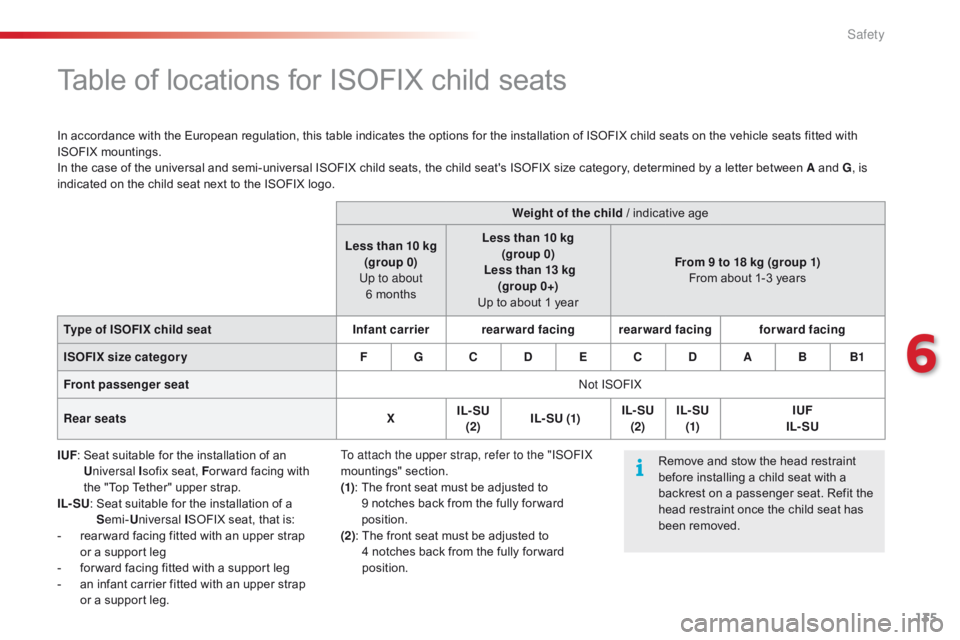
135
C1_en_Chap06_securite_ed01-2016
Table of locations for ISOFIX child seats
In accordance with the European regulation, this table indicates the options for the installation of ISOFIX child seats on the vehicle seats fitted with ISOFIX m ountings.
In
the case of the universal and semi-universal ISOFIX child seats, the child seat's ISOFIX size category, determined by a letter between A and G, is
indicated
on the child seat next to the ISOFIX logo.
IUF :
S
eat suitable for the installation of an
Un
iversal I sofix
seat, For ward
facing with
t
he "Top Tether" upper strap.
IL- SU :
S
eat suitable for the installation of a
Se
mi-Universal I SOFIX
seat, that is:
-
r
ear ward facing fitted with an upper strap
o
r a support leg
-
f
or ward facing fitted with a support leg
-
a
n infant carrier fitted with an upper strap
o
r a support leg. Weight of the child
/ indicative age
Less than 10 kg (group 0)
Up to about 6 months Less than 10 kg
(group 0)
Less than 13 kg (group 0+)
Up
to about 1 yearFrom 9 to 18 kg (group 1)
From
about 1-3 years
Type of ISOFIX child seat Infant carrierrearward facing rearward facing forward facing
ISOFIX size categor y F G C D E C D A B B1
Front passenger seat Not ISOFIX
Rear seats XIL- SU
(2) I L- SU (1) IL- SU
(2) IL- SU
(1) IUF
IL- SU
Remove
and stow the head restraint
b
efore installing a child seat with a
b
ackrest on a passenger seat. Refit the
h
ead restraint once the child seat has
b
een removed.
To attach the upper strap, refer to the "ISOFIX
mountings"
se
ction.
(1) :
T
he front seat must be adjusted to
9
notches back from the fully for ward
p
osition.
(2):
T
he front seat must be adjusted to
4 n
otches back from the fully for ward
p
osition.
6
Safety
Page 138 of 269
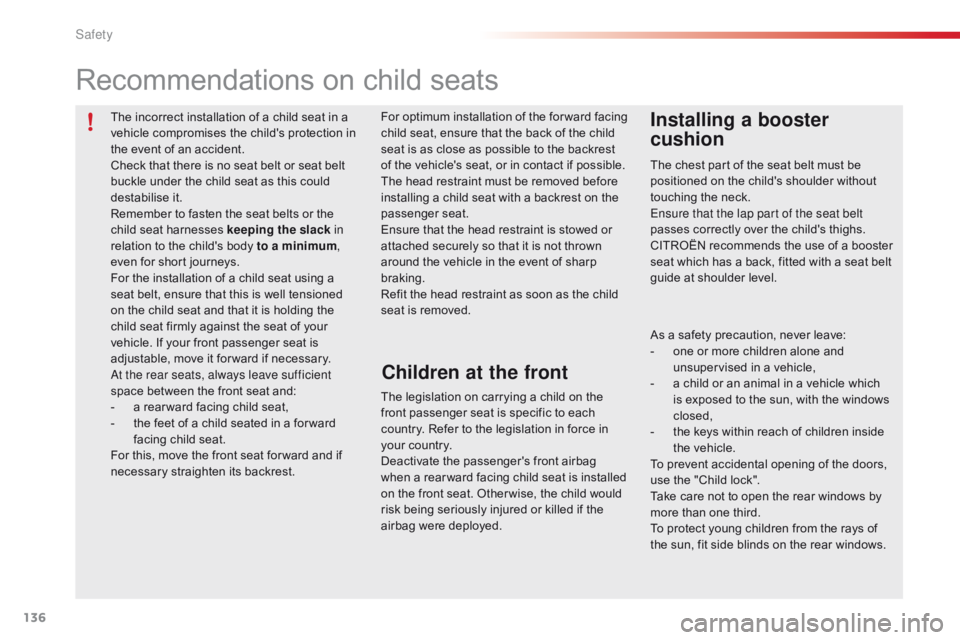
136
C1_en_Chap06_securite_ed01-2016
The incorrect installation of a child seat in a vehicle compromises the child's protection in
t
he event of an accident.
Check
that there is no seat belt or seat belt
b
uckle under the child seat as this could
de
stabilise
i
t.
Remember
to fasten the seat belts or the
c
hild seat harnesses keeping the slack in
relation
to the child's body to a minimum,
even
for short journeys.
For
the installation of a child seat using a
s
eat belt, ensure that this is well tensioned
o
n the child seat and that it is holding the
c
hild seat firmly against the seat of your
v
ehicle. If your front passenger seat is
a
djustable, move it for ward if necessary.
At the rear seats, always leave sufficient
space
between the front seat and:
-
a
rear ward facing child seat,
-
t
he feet of a child seated in a for ward
f
acing child seat.
For
this, move the front seat for ward and if
n
ecessary straighten its backrest.
Recommendations on child seats
The chest part of the seat belt must be positioned on the child's shoulder without
t
ouching the neck.
Ensure that the lap part of the seat belt
passes
correctly over the child's thighs.
CITROËN
recommends the use of a booster
s
eat which has a back, fitted with a seat belt
g
uide at shoulder level.
As
a safety precaution, never leave:
-
o
ne or more children alone and
u
nsupervised in a vehicle,
-
a
child or an animal in a vehicle which
i
s exposed to the sun, with the windows
c
losed,
-
t
he keys within reach of children inside
t
he vehicle.
To
prevent accidental opening of the doors,
u
se the "Child lock".
Take
care not to open the rear windows by
m
ore than one third.
To
protect young children from the rays of
t
he sun, fit side blinds on the rear windows.
The
legislation
on
carrying
a
child
on
the
f
ront
passenger
seat
is
specific
to
each
c
ountry.
Refer
to
the
legislation
in
force
in
y
our
country.
Deactivate
the
passenger's
front
airbag
w
hen
a
rear ward
facing
child
seat
is
installed
o
n
the
front
seat.
Other wise,
the
child
would
r
isk
being
seriously
injured
or
killed
if
the
a
irbag
were
deployed.
For
o
ptimum
in
stallation
o
f
t
he
fo
rward
f
acing
c
hild
seat,
ensure
that
the
back
of
the
child
s
eat
is
as
close
as
possible
to
the
backrest
o
f
the
vehicle's
seat,
or
in
contact
if
possible.
The
head
restraint
must
be
removed
before
i
nstalling
a
child
seat
with
a
backrest
on
the
p
assenger
sea
t.
Ensure
that
the
head
restraint
is
stowed
or
a
ttached
securely
so
that
it
is
not
thrown
a
round
the
vehicle
in
the
event
of
sharp
b
raking.
Refit
the
head
restraint
as
soon
as
the
child
s
eat
is
removed.
Installing a booster
cushion
Children at the front
Safety